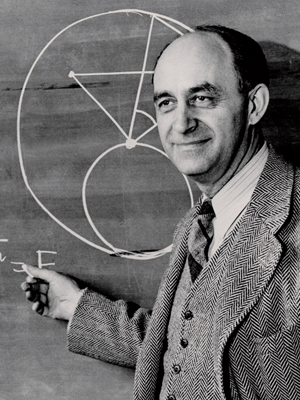
Masonic Biographies
Enrico Fermi
Born: Sunday, 29 September 1901
Died: Sunday, 28 November 1954
Enrico Fermi was a nuclear physicist, Nobel Prizewinner, and Freemason who made substantial contributions to science in Quantum Theory, Physics, and Statistical Mechanics.
Referred to as the “architect of the nuclear age,” Enrico Fermi was a nuclear physicist, a Nobel Prizewinner, and a Freemason. Throughout his prolific career, he made substantial contributions to the fields of Quantum Theory, Statistical Mechanics, and Nuclear and Particle Physics. Fermi excelled at both experimental and theoretical work, a distinction accomplished by few physicists.
Born in Rome in 1901, Enrico Fermi’s fascination with Physics began at age 14, following the tragic death of his older brother Giulio. From that point on, Enrico’s passion for physics became the focal point of his life. His understanding was so advanced in the subject that his entrance essay for the University of Pisa was deemed equivalent to the work of a doctoral student. There he received his undergraduate and doctoral degrees, and he published his first important scientific work in 1922, his year of graduation.
Enrico Fermi became a Freemason joining the Adriano Lemmi Lodge in Rome, under the Gran Loggia d’italia di Piazza del Geso. His intellectual curiosity made him a natural fit for the studies of Freemasonry, and he rose to the degree of Master Mason in 1923. His climb towards greatness continued as was he was appointed Professor of Theoretical Physics at the University of Rome at the age of 24. In the 1930s, he conducted a series of experiments to study the impacts of bombarding various elements with neutrons. This work led to the successful splitting of Uranium atom, for which he was awarded the Nobel Prize for Physics in 1938. Fearing for the safety of his Jewish wife, they began searching for an escape from the impending genocide. Soon after, Enrico and Laura emigrated to the United States, fleeing the Fascist Regime's takeover of Italy.
Upon the discovery of nuclear fission, he went to the University of Chicago, and later to Los Alamos to serve as a general consultant. Brother Fermi contributed significantly to the Manhattan Project, the creation of the first U.S. atomic bomb. As a leading member of the Manhattan Project, Bro. Fermi worked on the development of nuclear energy and the atomic bomb, although he was a vocal critic of the use of the technology as a military weapon. Brother Fermi was elected Fellow of the Royal Society on April 27, 1950. In his later years, he did important work in particle physics and was an inspiring teacher at the University of Chicago. In 1954, he died of stomach cancer at the age of 53.
He labored for the betterment of humanity, yet, his research ultimately led to the creation and utilization of the atomic bombs which killed over 200,000 of the citizens of Hiroshima and Nagasaki, Japan. Brother Enrico was adamantly opposed to the utilization of the hydrogen bomb, yet, he ultimately argued for the development of knowledge regardless of the consequences of the use of that knowledge.
